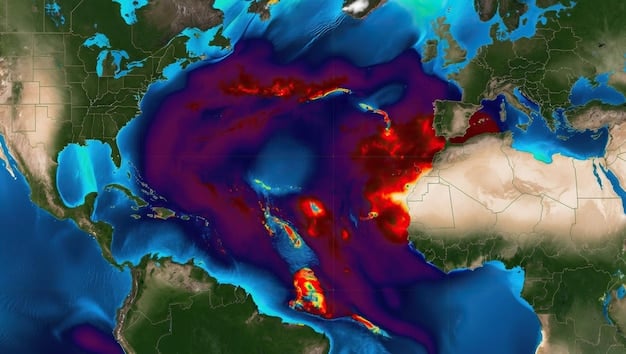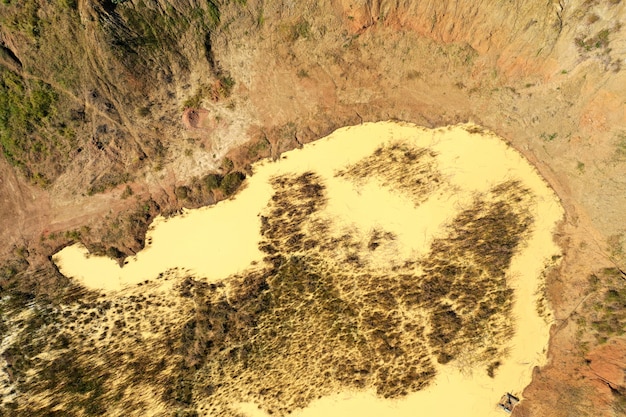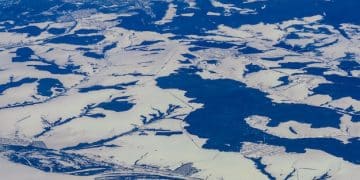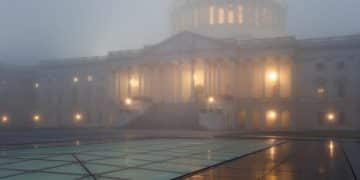Latest Scientific Findings: Climate Change and Extreme Weather in the US

The latest scientific findings strongly link climate change to an increased frequency and intensity of extreme weather events across the United States, driven by greenhouse gas emissions and observed through changes in precipitation patterns, heatwaves, and tropical cyclones.
Understanding the interplay between a changing climate and the escalating intensity of extreme weather events across the United States is critical. What are the latest scientific findings on the relationship between climate change and extreme weather events in the US, and how are these insights shaping our understanding of the planet’s future?
The undeniable link between warming climate and extreme heat
The scientific consensus continues to firm around the direct correlation between rising global temperatures—a hallmark of climate change—and the intensification of extreme heat events in the US. Data from meteorological stations and satellite observations consistently show an upward trend in both the frequency and duration of heatwaves across various regions. This isn’t merely an anecdotal observation; it’s a statistically significant shift confirmed by decades of rigorous data analysis.
One of the primary mechanisms driving this phenomenon is the increased atmospheric retention of heat due to elevated concentrations of greenhouse gases. These gases, primarily carbon dioxide and methane, act like a blanket, trapping solar radiation and leading to a gradual but persistent warming of the planet. This blanket effect means that when high-pressure systems settle over a region, dissipating clouds and allowing sunlight to bake the ground, the underlying air mass is already warmer, pushing temperatures into unprecedented highs. Such conditions contribute to record-breaking temperatures, impacting human health, infrastructure, and ecosystems.
Observed trends across US regions
Different parts of the US experience heat differently, yet the overall trend remains consistent. The Southwest, for instance, has seen a dramatic increase in the number of days exceeding 100°F (37.8°C), leading to prolonged drought conditions and increased wildfire risk. The Pacific Northwest, traditionally more temperate, has also experienced severe heatwaves, challenging its unprepared infrastructure and population. Even the typically humid Southeast is encountering more frequent and intense heat, exacerbated by high dew points.
- The frequency of heatwaves has doubled in major US cities since the 1960s.
- Nights are warming faster than days, reducing natural heat relief and increasing health risks.
- Urban heat islands intensify these effects, making cities particularly vulnerable.
- Record-breaking extreme heat events have become more common than record-breaking cold snaps.
These regional analyses provide granular detail to the broader picture. Scientists utilize sophisticated climate models, coupled with historical data, to attribute specific heat events to human-induced climate change. While natural variability always plays a role, the human fingerprint on the scale and intensity of recent heatwaves is increasingly clear. This scientific confidence is critical for policy-makers and communities as they plan for future resilience and adaptation.
The long-term health implications for vulnerable populations, including the elderly and those with pre-existing conditions, are also a growing concern. The scientific community emphasizes that while adaptation measures like cooling centers and early warning systems are crucial, mitigating the underlying drivers of climate change remains the most effective long-term solution.
Shifting precipitation patterns: droughts and intense rainfall
Climate change is fundamentally altering the global water cycle, leading to a phenomenon where “the wet get wetter and the dry get drier.” In the US, this translates into a paradoxical reality: some regions are experiencing prolonged and severe droughts, while others are grappling with more intense and frequent heavy rainfall events. This divergence poses significant challenges for water management, agriculture, and urban planning.
The scientific understanding behind these shifts points to a warmer atmosphere’s increased capacity to hold moisture. For every 1°C increase in temperature, the atmosphere can hold approximately 7% more water vapor. When conditions are right, this increased atmospheric moisture can be released as torrential downpours, leading to flash floods and overwhelmed drainage systems. Conversely, in regions experiencing persistent high-pressure systems and reduced moisture transport, this same warming can accelerate evaporation from soils and water bodies, exacerbating drought conditions.
Drought intensification and widespread impacts
The Western US, in particular, has been in the throes of a multi-decade megadrought, now understood to be the most severe in at least 1,200 years. Recent studies confirm that human-caused climate change is responsible for a substantial portion of this drought’s severity. Reduced snowpack in mountain ranges, a critical natural water reservoir, directly impacts water availability for agriculture, urban centers, and hydropower generation. The implications extend far beyond water supply, affecting ecosystems, increasing wildfire susceptibility, and leading to agricultural losses.
- Snowpack declines in the Sierra Nevada and Rocky Mountains are directly linked to warming temperatures.
- Reservoir levels in major water sources like Lake Mead and Lake Powell have reached historic lows.
- Drought conditions are fueling more intense and prolonged wildfire seasons, particularly in California and the Pacific Northwest.

Escalating extreme rainfall events
Concurrently, many other parts of the US are witnessing more extreme precipitation. The Midwest, Northeast, and parts of the Southeast have experienced an increase in the frequency and intensity of heavy downpours. These events can occur rapidly, leading to flash flooding even in areas not typically flood-prone. Urban areas, with extensive impervious surfaces, are particularly vulnerable as stormwater runoff is accelerated, overwhelming infrastructure.
Researchers use advanced climate models to project future precipitation changes, indicating a likely continuation of these divergent trends. Understanding these nuanced shifts is vital for developing effective climate adaptation strategies, ranging from water conservation policies in arid regions to enhanced flood protection in areas prone to heavy rainfall.
The economic costs associated with these events are substantial, affecting insurance markets, agricultural yields, and the stability of communities. Scientific findings underscore the need for integrated water management solutions that account for both deficits and excesses, recognizing that these are two sides of the same climate change coin.
Tropical cyclones: intensity, rapid intensification, and rainfall
The relationship between climate change and tropical cyclones—hurricanes, typhoons, and tropical storms—is a complex but increasingly clear area of scientific inquiry. While the total number of tropical cyclones globally might not be increasing, the consensus is that the most intense storms are becoming more frequent and powerful, and they are carrying significantly more rainfall. This trend has profound implications for coastal communities in the US.
A warmer ocean surface provides more energy for tropical cyclones. Hurricanes draw their power from latent heat released when warm, moist air rises and condenses. As ocean temperatures rise, there’s more heat available, allowing storms to reach higher maximum wind speeds and sustain their intensity for longer. This is particularly noticeable in the phenomenon of “rapid intensification,” where a tropical cyclone gains significant strength in a short period, often making it difficult for forecasters and emergency managers to prepare communities adequately.
Hurricane impacts on US coastlines
The Atlantic and Gulf coasts of the US are particularly vulnerable. Recent hurricane seasons have delivered a succession of powerful storms, inflicting billions of dollars in damages and causing significant loss of life. Beyond wind speed, the increased rainfall associated with these storms is a major concern. Warmer atmospheres hold more moisture, leading to higher precipitation rates during tropical cyclone landfalls. This exacerbates inland flooding, even far from the coast, turning what might have historically been a wind-driven event into a combined wind and deluge disaster.
- The North Atlantic region has seen an observed increase in the intensity of tropical cyclones.
- Rapid intensification events are becoming more common, posing greater challenges for warnings.
- Sea level rise, driven by thermal expansion and melting ice, exacerbates storm surge impacts along coastlines.
- Forecasts project an increase in Category 4 and 5 hurricanes, though total numbers may remain stable or decrease slightly.
Another critical factor is sea level rise. As global temperatures climb, oceans expand and meltwater from glaciers and ice sheets contributes to rising sea levels. This elevates the base level for storm surge, meaning that even a relatively weaker storm can push water much farther inland and cause more extensive coastal flooding than it would have a few decades ago. This amplifies the destructive potential of all tropical cyclones, regardless of their peak intensity.
Scientists employ a combination of historical data analysis, advanced climate modeling, and real-time monitoring to understand these trends. Attribution studies are increasingly able to quantify the extent to which climate change has influenced specific hurricane characteristics, such as rainfall totals. These findings underpin the urgency for coastal resilience measures, including infrastructure upgrades, wetland restoration, and improved early warning systems, even as global efforts to reduce emissions continue.
Wildfires: an escalating threat in a warming world
The scientific community has established a robust connection between climate change and the increasing prevalence and intensity of wildfires, particularly in the Western US. While wildfires are a natural part of many ecosystems, human-induced climate change is creating conditions that make them larger, more frequent, and more destructive. This is primarily driven by prolonged drought, earlier snowmelt, increased temperatures, and changes in vegetation.
A primary mechanism is the “fuel aridity deficit.” Warmer temperatures and reduced precipitation, characteristic of climate change, dry out vegetation to extreme levels. Forests and grasslands become highly combustible, acting like kindling for fires. Earlier spring thaws mean that vegetation dries out earlier in the season and stays dry for longer, extending the wildfire season. This creates a longer window for fires to ignite and spread rapidly.
Impacts on ecosystems and human communities
The interconnectedness of these factors is critical. For instance, the increased intensity of heatwaves leads directly to greater evaporation and dry fuels. Drought conditions stress trees, making them more susceptible to insect infestations, which further increases the amount of dead and dry biomass available to burn. This creates a dangerous feedback loop where drier, hotter conditions fuel larger fires, which in turn can alter ecosystems in ways that make them more prone to future fires.
- Average wildfire season length in the US has increased by several weeks since the 1970s.
- The area burned annually by wildfires has more than doubled since the 1980s.
- Megafires, burning over 100,000 acres, are becoming more common.
- Wildfire smoke contributes significantly to air pollution, impacting respiratory health across vast regions.
The impacts extend far beyond the direct destruction from fires. Smoke from large wildfires can travel thousands of miles, affecting air quality and public health in distant urban centers. The economic costs are enormous, including firefighting expenses, property damage, and impacts on tourism and agriculture. Scientists employ various tools, from dendrochronology (tree-ring analysis) to paleoclimate data and modern climate models, to accurately attribute these trends to human activities.
Recent studies show that the human influence on climate has roughly doubled the area burned by forest fires in the Western US since the 1980s. This compelling evidence underscores the urgency of both reducing greenhouse gas emissions and implementing comprehensive wildfire management strategies, including prescribed burns, forest thinning, and community resilience planning, to adapt to this new fire reality.
Arctic amplification and its influence on US weather
Arctic amplification refers to the phenomenon where the Arctic region is warming at a rate two to four times faster than the rest of the planet. This rapid warming has profound implications for global weather patterns, including those experienced in the contiguous US. While still an active area of research, emerging scientific findings suggest that Arctic amplification may be contributing to more extreme and persistent weather events across mid-latitudes.
The primary mechanism proposed is the weakening and more meandering path of the stratospheric polar vortex and the jet stream. The polar vortex is a vast area of low pressure and cold air surrounding the Earth’s poles. The jet stream, a fast-flowing current of air in the upper atmosphere, typically acts as a boundary, keeping cold Arctic air contained. The significant temperature difference between the Arctic and mid-latitudes drives the strength and stability of the jet stream.
Disruptions to the jet stream
As the Arctic warms more rapidly, this temperature difference lessens. When the temperature gradient weakens, the jet stream tends to become wavier, dipping further south and extending further north. These deeper “troughs” and “ridges” can lead to prolonged periods of unusual weather. For example, a deep southward trough can bring frigid Arctic air unusually far south, leading to severe winter storms and prolonged cold snaps, even as overall global temperatures rise.
- The Arctic is warming significantly faster than the global average.
- Reduced sea ice cover contributes to Arctic amplification by decreasing the Earth’s reflectivity.
- A wavier jet stream can lead to more persistent weather patterns, including heatwaves and cold snaps.
- The exact strength of the Arctic-mid-latitude teleconnection is still being refined by scientists.
Conversely, a persistent poleward ridge can trap warm air, leading to extended heatwaves and drought. The concept of “weather whiplash” or “stuck patterns” is often used to describe these phenomena, where weather systems become stationary for longer periods, intensifying their impacts.
While definitive, one-to-one causal links for every specific extreme event are complex and subject to ongoing research, the general scientific consensus is that Arctic changes are altering the dynamics of atmospheric circulation that influence US weather. Studies using advanced atmospheric models and observational data are consistently trying to unravel the precise mechanisms and the extent of Arctic amplification’s influence.
Understanding these teleconnections is crucial for improving long-range weather forecasting and climate projections, helping communities prepare for potentially more extreme and unpredictable weather patterns, regardless of the overall warming trend. It adds another layer of complexity to the climate change narrative, emphasizing the interconnectedness of Earth’s climate systems.
Future projections and adaptation strategies
The scientific findings outlined above paint a clear picture: the relationship between climate change and extreme weather events in the US is strengthening, and this trend is projected to continue, and in many cases intensify, throughout the 21st century. Climate models, becoming increasingly sophisticated, project a future where extreme heat becomes even more common, heavy precipitation events increase in intensity, wildfires consume larger areas, and the most powerful tropical cyclones grow stronger. These projections are based on various emissions scenarios, with higher emissions leading to more severe impacts.
For instance, under a high-emissions scenario, many parts of the US are projected to experience dozens more days above 90°F (32.2°C) annually by mid-century. The frequency of 100-year flood events is expected to increase significantly in many river basins. Coastal flooding will become more regular due to continued sea level rise combined with storm surges. These aren’t abstract academic exercises but tangible challenges that communities across the US already face.
Mitigation and adaptation: dual imperatives
Addressing these future projections requires a dual approach: mitigation and adaptation. Mitigation involves reducing greenhouse gas emissions to slow or halt the progression of climate change itself. This includes transitioning to renewable energy, improving energy efficiency, and developing sustainable land-use practices. Every increment of warming avoided will result in a measurable reduction in the severity and frequency of extreme weather events.
- Investing in renewable energy sources like solar and wind power.
- Improving national energy efficiency standards for buildings and transportation.
- Protecting and restoring natural carbon sinks, such as forests and wetlands.
- Developing carbon capture and storage technologies.
However, given the climate change already locked in by past emissions, adaptation is equally critical. Adaptation strategies aim to reduce the vulnerability of communities and ecosystems to the impacts of extreme weather. This includes a wide range of measures, from structural engineering solutions to community planning and early warning systems.
Examples of adaptation strategies include building sea walls and restoring coastal wetlands to protect against storm surge, upgrading stormwater infrastructure to handle heavier rainfall, developing advanced heatwave warning systems and cooling centers, improving forest management practices to reduce wildfire risk, and implementing drought-resistant agricultural techniques. Effective adaptation planning requires robust scientific data and localized assessments of vulnerability and risk.
The scientific community emphasizes that while mitigation must be a global effort, adaptation often needs to be tailored to specific regional contexts. Research continues to refine these projections and evaluate the effectiveness of various adaptation strategies, providing crucial guidance for policymakers and communities grappling with the immediate and future realities of climate change-driven extreme weather.
Societal implications and policy responses
The increasing frequency and intensity of extreme weather events driven by climate change have profound societal implications across the US. These impacts are not uniform; they disproportionately affect vulnerable populations, exacerbate existing inequalities, and strain public resources. Understanding these societal dimensions is crucial for developing equitable and effective policy responses.
Economic Costs: The financial toll of extreme weather events is staggering. Billions of dollars are lost annually due to property damage, agricultural losses, infrastructure destruction, and business disruption. Insurance markets are increasingly challenged, and the burden of recovery often falls disproportionately on taxpayers and those least able to afford it. Moreover, the chronic stress from recurrent disasters can hinder long-term economic development in affected regions.
Public Health Crisis: Extreme heat is a leading cause of weather-related deaths, and its impacts are compounded in urban heat islands. Wildfire smoke contributes to respiratory and cardiovascular illnesses across vast areas. Increased heavy rainfall and flooding can lead to waterborne diseases and mental health impacts from displacement and trauma. These health consequences disproportionately affect the elderly, children, outdoor workers, and those with limited access to healthcare.
Addressing equity in climate resilience
The concept of climate justice underscores that those who have contributed least to climate change often bear the brunt of its impacts. Marginalized communities, including low-income populations and communities of color, frequently live in areas more susceptible to hazards, have fewer resources for recovery, and face systemic barriers to accessing aid. Effective policy responses must address these inequities directly, ensuring that adaptation measures and disaster relief efforts prioritize vulnerable groups and build their capacity for resilience.
- Implementing federal programs that support climate-resilient infrastructure in disadvantaged communities.
- Developing early warning systems that are accessible to all demographics, including non-English speakers.
- Investing in green infrastructure solutions that provide multiple benefits, such as flood protection and urban cooling.
- Formulating policies to ensure equitable access to insurance and disaster relief funding.
Infrastructure Vulnerability: Much of the US infrastructure was built for a climate that no longer exists. Roads buckle from extreme heat, power grids fail during heatwaves and storms, and wastewater treatment plants are overwhelmed by heavy rainfall. Updating and “hardening” this infrastructure to withstand future extreme conditions is a massive undertaking, requiring significant investment and long-term planning.
Policy responses must therefore be multi-faceted. They include stringent regulations on emissions to meet ambitious climate targets, significant investments in climate-resilient infrastructure, comprehensive disaster preparedness and response frameworks, and robust social safety nets to support affected communities. Furthermore, there is a growing recognition for integrating climate considerations into all aspects of governance, from urban planning to public health initiatives.
The scientific findings provide the factual basis for these policy decisions, urging a proactive and just transition towards a more resilient and sustainable future. This requires not just technological solutions but also fundamental changes in governance, resource allocation, and societal priorities to protect communities from the escalating threats of extreme weather.
| Key Point | Brief Description |
|---|---|
| 🌡️ Extreme Heat | Increased frequency and intensity of heatwaves linked directly to rising global temperatures, impacting health and infrastructure. |
| 💧 Precipitation Shifts | Divergent trends with more severe droughts in some regions (e.g., Western US) and heavier rainfall in others (e.g., Midwest). |
| 🌀 Tropical Cyclones | More intense storms, higher rapid intensification rates, and increased rainfall totals observed, exacerbated by sea level rise. |
| 🔥 Wildfire Escalation | Larger, more frequent, and destructive wildfires driven by hotter, drier conditions and prolonged drought. |
Frequently Asked Questions about Climate Change and US Extreme Weather
▼
No, not every single extreme weather event is “caused” by climate change. However, scientific attribution studies increasingly show that climate change makes many types of extreme events, such as heatwaves, heavy rainfall, and some droughts, more probable, more intense, or longer-lasting than they would have been without human influence.
▼
Climate change intensifies hurricanes primarily by warming ocean waters, which provides more energy for storms to strengthen. This leads to higher maximum wind speeds, more rapid intensification, and increased rainfall due to a warmer, moister atmosphere. Sea level rise also exacerbates storm surge impacts along coastal areas during landfalls.
▼
Arctic amplification is the phenomenon where the Arctic region warms significantly faster than the global average. This rapid warming can weaken the temperature difference between the Arctic and mid-latitudes, potentially leading to a wavier and more persistent jet stream, which can cause longer duration extreme weather events in the US, like prolonged heatwaves or cold snaps.
▼
Yes, scientific findings indicate that human-caused climate change is intensifying drought conditions in parts of the US, particularly the Western states. Warmer temperatures increase evaporation from soils and water bodies, leading to drier conditions and reduced snowpack, which is a critical water source for many regions.
▼
Addressing impacts requires both mitigation (reducing greenhouse gas emissions through renewable energy, energy efficiency) and adaptation (building resilient infrastructure, improving early warning systems, restoring natural defenses). These dual strategies are vital to lessen future impacts and protect communities from the extreme weather already locked in.
Conclusion
The latest scientific findings unequivocally establish a robust and escalating relationship between climate change and extreme weather events across the United States. From the intensifying heatwaves baking urban centers to the paradoxical dance of droughts and torrential downpours, and from the more potent tropical cyclones battering coastlines to the rampant wildfires consuming vast landscapes, the evidence is compelling and growing. These changes are not isolated incidents but rather interconnected consequences of a warming planet, largely driven by human activities. The scientific community’s rigorous research continues to refine our understanding of these complex interactions, providing critical insights that must inform proactive policy responses, substantial infrastructure investments, and equitable adaptation strategies to build a more resilient future for communities nationwide.





